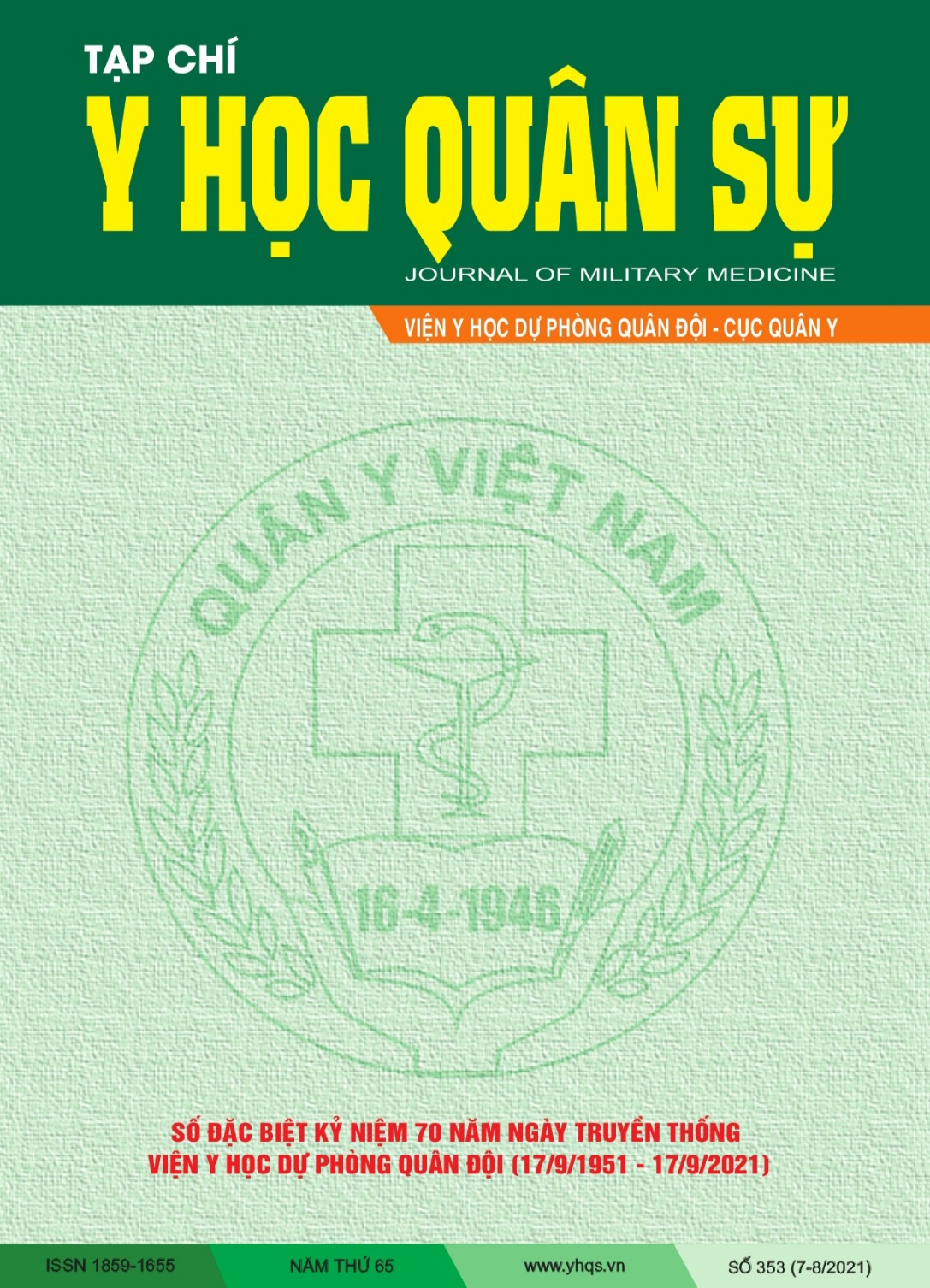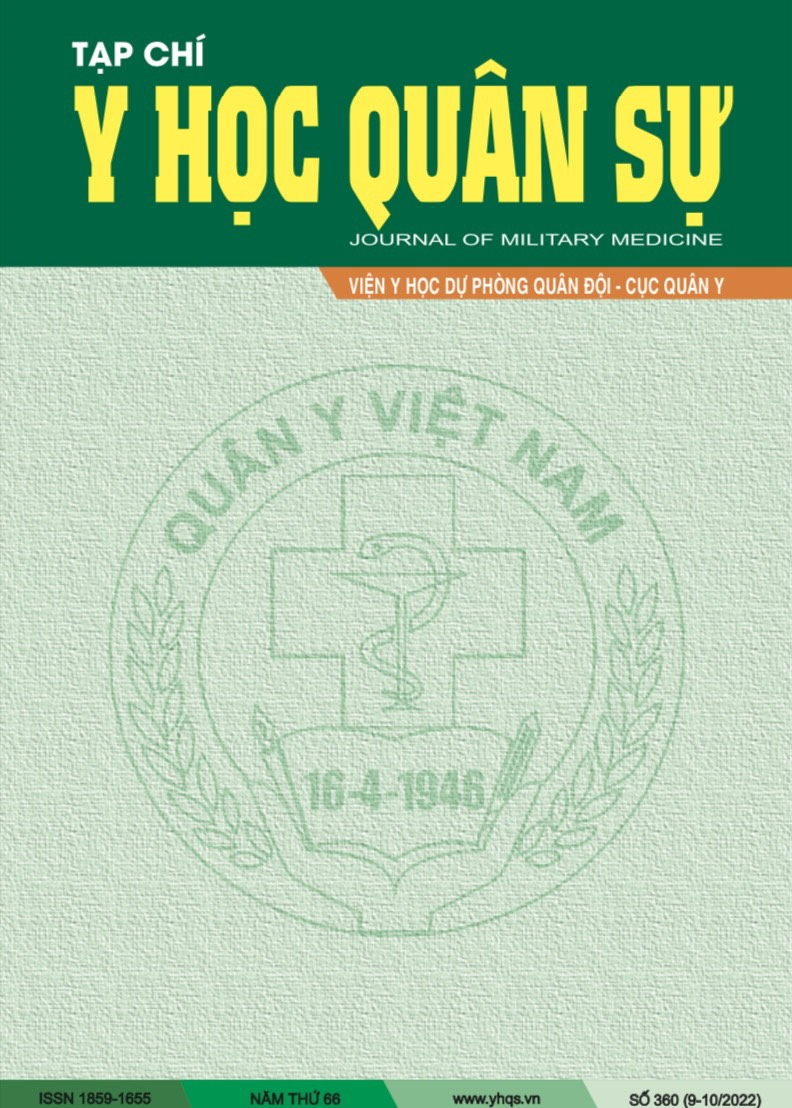NGHIÊN CỨU HOẠT TÍNH KHÁNG KHUẨN VÀ KHẢ NĂNG SINH TỔNG HỢP MYCOPHENOLIC ACID CỦA CHỦNG VI NẤM BIỂN
Từ khóa:
Vi nấm biển, kháng khuẩn, MPA, Penicillium spTóm tắt
Nghiên cứu hoạt tính kháng khuẩn và khả năng sinh tổng hợp Mycophenolic acid của các chủng vi nấm phân lập được từ trầm tích biển Việt Nam bằng phương pháp khuếch tán đĩa thạch. Kết quả: Trong 12 chủng nấm, có 9 chủng kháng 2 đến 5 vi sinh vật kiểm định; trong đó, có các chủng G 1.1, CS 5.1, GS 1.3, GS 1.5 và K 7.1 kháng cả 5 vi sinh vật kiểm định với đường kính vòng kháng khuẩn lớn nhất từ 18-25 mm. Đồng thời, cả 5 chủng nấm này đều có khả năng sinh tổng hợp Mycophenolic acid. Chủng G 1.1 có hoạt tính sinh tổng hợp Mycophenolic acid cao nhất và cũng là chủng có phổ kháng vi sinh vật kiểm định rộng, hoạt tính cao nhất. Chủng vi nấm biển tiềm năng G 1.1 được định danh bằng đặc điểm hình thái kết hợp với phân tích trình tự đoạn gen ITS (ITS1 - 5.8S - ITS4) và được gọi là Penicillium roqueforti G 1.1. Kết quả này là cơ sở khoa học để nghiên cứu khai thác chủng vi nấm biển Penicillium roqueforti G 1.1 ứng dụng trong y dược tại Việt Nam.
Tài liệu tham khảo
Blunt John W, Carroll Anthony R, Brent R Copp, Rohan A Davis, Robert A Keyzers, Mich ele R Prinsep (2018), Marine natural products, The Royal Society of Chemistry 2018.
Blunt John W, Copp B.R, Keyzers R.A, Munro M.H.G, Prinsep M.R (2017), Nature Product, 34, 235-294.
Demain A.L, Sanchez S (2009), “Microbial drug discovery: 80 years of progress”, J Antibiot (Tokyo) 62, 5-16.
Huang Yu-Tuan, Lowe David J, Churchman G Jock, Louis A Schipper, Nicolas J Rawlence, Alan Cooper (2014), Carbon Storage and DNA Adsorption in Allophanic Soils and Paleosols.
Shi Y, Eissenstat D.M, He Y, Davis K.J (2018), “Using a spatially-distributed hydrologic biogeochemistry model with a nitrogen transport module to study the spatial variation of carbon processes in a Critical Zone Observatory”, Ecological Modelling, 380: 8-21.
Luo Arong, Ling Cheng, Simon Y.W, Zhu Chao (2018), “Comparison of Methods for Molecular Species Delimitation Across a Range of Speciation Scenarios”, Systematic Biology, 67 (5).
Leclercq S, Mian M.F, Stanisz A.M, Bindels L, Cambier E, Amram H, Koren O, Forsythe P, Bienenstock J (2017), “Low-dose penicillin in early life induces long-term changes in murine gut microbiota, brain cytokines and behavior”, Nature communications, 8: 15062.
Marto A, Mohd Y, Pakir F, Latifi N, Hakimi A, Choy Soon Tan (2015), “Stabilization of Marine Clay by Biomass Silica (non-traditional) Stabilizers”, Applied Mechanics and Materials, 695, 93-97.
Ardestani F (2011), “Enhanced Mycophenolic acid production by Penicillium brevicompactum with enzymatically hydrolyzed casein”, Wold academy of Sicence, engineering and technology 49.
Franz Hadacek, Harald Greger (2000), “Testing of antifungal natural products: methodologies, comparability of results and assay choice”, Phytochemical Analysis.
Bùi Xuân Đồng (1977), Một số vấn đề về nấm học, Nhà xuất bản Khoa học và Kỹ thuật.
Ainsworth G.C, Sussman A.S (1969), (Editors), The Fungi, Vol. III - The Fungal Population.
Kurtzman C.P (2014), “Use of gene sequence analyses and genome comparisons for yeast systematics”, Evolution Microbiology, 64 (2): 325-332.
Torsen Bak Regueira (2011), Molecular Basis for mycophenolic Acid Biosynthesis in Penicilium brevicompactum. App. and Enviroment Micro: 3035-3043.
Song L (2019), “Regulating the Golgi apparatus sorting of proteinase A to decrease its excretion in Saccharomyces cerevisiae”, Microbiol Biotechnol, 46 (5): 601-612.
Vinokurova N.G, Ivanushkina G, Kochkina G.A, Arinbasarov M.U (2005), “Production of Mycophenolic acid by fungi of the genus Penicillium link”, Appl Biochem Microbiol: 83-86.
Juki N, John R, Juliet B, Daniel W, Jacobson P.A (2006), “A limited sampling model for estimation of total and unbound mycophenolic acid (MPA) area under the curve (AUC) in hematopoietic cell transplantation (HCT)”, Ther Drug Monit, 28 (3): 394-401.
Domhan S, Muschal S, Schwager C, Morath C, Wirkner U, Ansorge W, Maercker C, Zeier M, Huber P.E (2008), “Molecular mechanisms of the antiangiogenic and antitumor effects of mycophenolic acid”, Mol Cancer Ther, 7 (6): 1656-1668.
Morales R.R, Agrapart V, Mencacci C, Moretti C, Frajese G (2008), “Functional re-differentiation of prostate cancer derived cell lines by the anti-tumoral drug mycophenolic acid”, EJC Suppl, 6 (9): 146-146.
Heischmann S, Dzieciatkowska M, Hansen K, Leibfritz D, Christians U (2017), “The immunosuppressant mycophenolic acid alters nucleotide and lipid metabolism in an intestinal cell model”, Sci Rep, 7 (1): 45088.
Cakmakci S, Gurses M, Hayaloglu A.A, Cetin B, Sekerci P, Dagdemir E (2015), “Mycotoxin production capability of Penicillium roqueforti in strains isolated from mould-ripened traditional Turkish civil cheese”, Food Addit Contam, 32 (2): 245-249.



